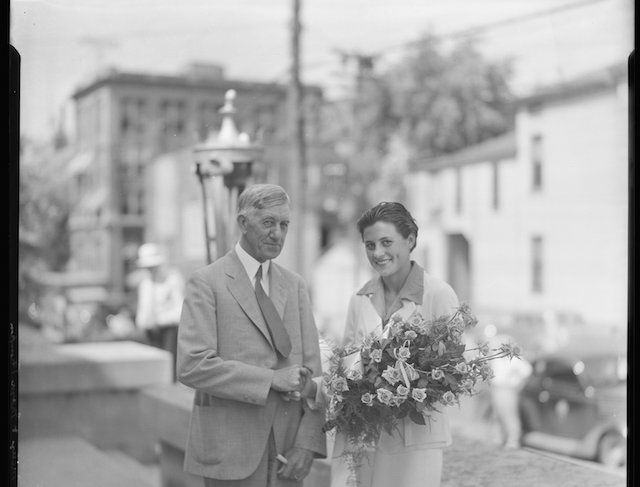 |
| Lexington Country Club in 2016. Author’s Collection. |
The charter member list of the Lexington County Club reads as a “who’s who” of Lexington at the turn of the twentieth century. This first social club in Lexington was modeled after the clubs common and popular in larger cities in the eastern United States so that these leaders (men only) would have a place to relax. The Lexington Leader, then the local Republican newspaper, outlined the club’s purpose for prospective members and donors:
Think of having a charming place near town in easy driving distance, with an opportunity to enjoy country life in its most finished sense! Where men after business hours can go and take their families and guests for luncheon or dinner, outdoor and indoor games, where there are beautiful lawns and tennis and golf grounds and society in general go for dances and all sorts of diversions. In this way the most wholesome kind of social enjoyment can be developed and people have that for which they so often long and sign, a perfect resort for entertainment outside of their own homes. In nearly ever other city in America there is something on this order – a country club or a hunting club.
And so it was in 1901 that the Lexington Country Club organized with a site selected along Paris Pike. In 1907, the house that was utilized for the clubhouse was reinvented by the Columbus, Ohio architecture firm Richards, McCarty & Bulford whose work features prominently elsewhere in Lexington. The landscape architects of the Olmsted Brothers firm worked on improvements to the property. The facilities finally opened in October 1907 to a gala event.
 |
| Lexington Country Club prior to the 1925 fire. UK Libraries. |
Fire and Rebirth
Eighteen years later – on October 19, 1925 – the clubhouse caught fire. Schoolchildren from the Falconer school across the road helped to remove furnishings before the fire became too strong while firefighters from Lexington were dispatched. Despite the effort, the clubhouse was a total loss then measured at only $50,000. The decision was made to rebuild at once.
At the time of the fire, the club’s board was considering what to do with its facility and how it might grow its physical space. Had they deliberated for just a few years longer without the intervening fire, it is a worthy question to ask would the club have survived had the fire come just a few years later? The Great Depression arose following Black Friday four years and ten days following the fire that consumed LCC.
Instead, the fire occurred during the throes of the Roaring Twenties and its grand reopening was realized in June, 1926. With its new facilities in place, the financial hardships brought on by the Depression and the Second World War were weathered by the club.
Marion Miley
None of these days, however, are the most remembered in club history. Instead, that honor is reserved for a more ghastly date: September 28, 1941.
In the early morning hours on that fall day, burglars broke into the Lexington Country Club hoping to retrieve money in the house which had been received during an event at the club earlier in the evening.
Miley arrived at the club as a resident on the club’s second floor when she was just 16: her father became the club’s golf pro and her mother managed the office. Though her father took a similar position in Cincinnati, both Marion Miley and her mother remained in Lexington. Miley’s golf game flourished winning many tournaments in the 1930s. By 1939, she was ranked #2 among amateur women golfers in the United States.
 |
| Marion Miley and Lexington Mayor Charles Thompson in 1935 on the steps of the old municipal building. UK Libraries. |
But on that fateful evening it was found that Marion heard the noise downstairs when she went to the door of the second floor apartments she shared with her mother. At the door, she was met by her assailant and she was shot at close range.
Though the floor has since been replaced and the second floor remodeled, the spot where Marion Miley fell can be seen in the club’s ladies locker room. The legacy of Marion Miley, however, is best represented in a room that bears her name and contains mementos from her life. Additionally, an annual memorial tournament is held in the club in her honor.
 |
| The Club’s Ballroom in February 2016. Author’s Collection. |
A Post-War Evolution
Following the Second World War, the club evolved once again. Many members left to join the newly reorganized Idle Hour Country Club nearer to town on Richmond Road. Meanwhile, the Lexington Country Club took a more “family” approach with the addition of a swimming pool and other expansions. Today, its modern facilities enclosed within the heart of a space built in the 1920s create a welcoming environment for members and their guests.
On Wednesday, March 3, the Blue Grass Trust for Historic Preservation’s monthly deTours program will highlight the historic Lexington Country Club with a tour that is – as it is each month – free and open to the public. Additional details are available on Facebook.
Much of the information about the Lexington Country Club provided in this post was derived from the book, Lexington Country Club: A History of the First One Hundred years 1901-2001 by Rick Smoot (2004).
























